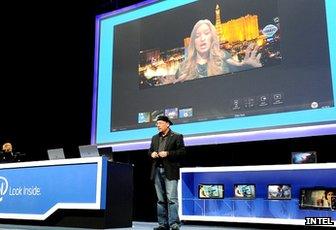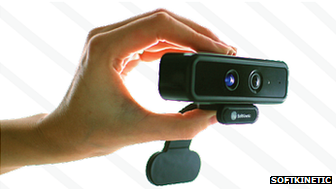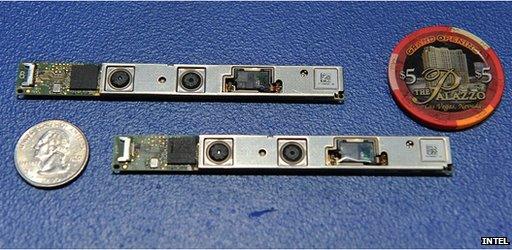CES 2014: Laptops to get Intel 3D depth sensing cameras
- Published

Intel's perceptual computing chief says that its 3D camera component will start appearing in laptops before the end of 2014
Intel has said that laptops featuring 3D-camera technology developed by the chipmaker will go on sale this year.
It said seven firms would release products that contained its software and hardware, which would be indentified by the RealSense brand.
At a press conference in Las Vegas, Intel showed how one of its depth sensors could be used to interpret gesture controls and to separate foreground objects from the background.
The idea itself is not new.
Microsoft's Kinect and SoftKinectic's Depthsense cameras already offer such functions. Apple recently bought another firm, PrimeSense, that also makes depth sensing hardware.

The cameras was used to superimpose a test subject over a backdrop of Las Vegas
But one expert said Intel's intervention could help the innovation go mainstream as a built-in component.
"This tech has been knocking around for a while, but Intel's move will give it fresh momentum," said Tony Crabtree, from the consultancy Juniper Research, who is attending the Consumer Electronics Show where the announcement was made.
"It needed a big player to help the market take off. Having said that, I don't see it as a transformative technology in the same way wearables or ultra-high definition screens will be."
Fake background
Intel named Acer, Asus, Dell, Fujitsu, HP, Lenovo and NEC as the first manufacturers to release RealSense branded kit.

SoftKinetic already offers add-on 3D depth sensing cameras
At CES it gave a demonstration of the tech using a version of Skype in which the camera was used to isolate the user's video image, extract it and superimpose it over a different background in real-time.
This mimicked an effect that would normally require a green screen and special compositing software.
It also showed how the software could turn the majority of a video feed black-and-white while leaving one of the objects in colour.
In another demo a member of Intel's team played a pinball video game by moving a real paddle in front of the computer's camera.
The company said that it believed that the use of other possible gestures could help educate children by making software more immersive.

Intel said that its RealSense camera is thinner than a Las Vegas casino chip
Several "edutainment" titles for Nintendo's Wii consoles are based on the same principle.
Intel added that it had formed a partnership with 3D Systems - one of the leading 3D printer makers - to let its kit be used to create real-world objects by shaping them in the air.
3D Systems had previously worked with another firm, GeoMagic, to offer this facility for its printers using the Kinect-to-3D-Scan app and Microsoft's sensor.
Wearable tech
Intel's chief executive Brian Krzanich also unveiled several new concept wearable technologies that the firm is developing, during a separate Keynote Address.

Intel's new chief executive gave his first CES Keynote address where he unveiled several prototypes
These included:
Smart earbuds, which act as an activity tracker as well as playing music, drawing their power from the attached machine's audio jack
A smart headset, nicknamed Jarvis, which hooks behind the user's ear. It is controlled by speech and is meant to allow the user to set up diary appointments, book restaurant tables and other such tasks
A smartwatch that can connect to the net without needing to be linked to a phone
Mr Krzanich also unveiled a computer called Edison, which is the size of an SD card but can run Linux-based operating systems and connect to wi-fi networks.
The company also confirmed it had developed a technology to allow a Windows computer powered by one of its chips to run certain Android apps under software emulation.